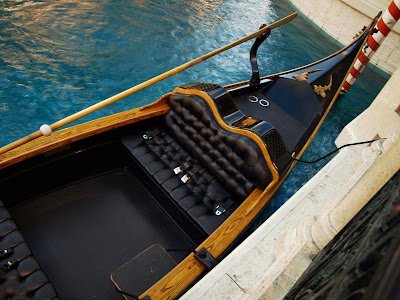 One cannot help but admire the detail put into the upholstery of these gondolas. It's not really reminiscent of a Venice-built gondola - more like a horse-drawn carriage, but the quality and comfort are impressive.
One cannot help but admire the detail put into the upholstery of these gondolas. It's not really reminiscent of a Venice-built gondola - more like a horse-drawn carriage, but the quality and comfort are impressive.The wood used as trim and seat framing was cut using standard patterns, but then each piece had to be handcrafted - some were placed in a very large steam-box to add the necessary curve. All screw fastenings were countersunk and plugged with matching wood before the whole thing was stained and varnished.
Seat belts?
You think you see seat belts in the salon?
Indeed there are seat belts, but not because these boats move at unsafe speeds.
The seat belt story goes back to a decision made by someone who was obviously worried about liability and lawsuits.
The main idea being that if a stupid drunk guy tries to stand up in the middle of the ride, and the boat is heading under a low bridge, he's less likely to hit his head on the bridge if he's buckled in.
And, more importantly, he's less likely to sue the casino.
As the boats are routinely boarded from the port side, a small step is located on that side. The top has a nonskid surface, and the step does a great job of keeping people from stepping on the upholstery.
Looking at the photo below, you can see the metal cap of the charging port, which is located on the inboard side of the step. During down time, this is where the charge cord is plugged in.
 These boats do have forcole, but the design has a serious difference: the morso is turned 90 degrees and serves as a holder for the remo, which is used more as a rudder than a propulsion oar.
These boats do have forcole, but the design has a serious difference: the morso is turned 90 degrees and serves as a holder for the remo, which is used more as a rudder than a propulsion oar.Over the years, the gondoliers who operate these boats have learned how to use the remo as an oar. The style of rowing could best be compared to the sotomorso style used when a Venetian gondolier has stepped forward onto the trastolini - trailing his remo behind him and making fishtail movements with the blade. At one time, I heard rumors about how some gondoliers there were refusing to use the motors and had to be chastized by management to insure that the motors were being used.
Why are the motors so important? As it has been explained to me, when all the boats have their throttles set at the same speed, and all gondoliers use the motors in the same places,
the flow of traffic is more manageable. Each boat's throttle can be adjusted, but the controls for that are under-deck.
Once again, liability has reared its head in another form: tendonitis of the wrist.
There are, from time to time, gondoliers who develop a painful movement-related condition of the right wrist. This is why you may see some gondoliers there wearing gloves or wrist braces.
I would imagine that blisters have also prompted some to wear gloves.
The threat of tendonitis has also supported the argument from management that using the motors was necessary.
So how do the gondoliers operate the motors?
They step gently on the buttons on the deck (you can see them more clearly in the top photo).
When I last checked, one was the on/off button for the carefully adjusted forward propulsion.
Step on it once and the boat goes forward.
Step again and it cuts power to the motors.
The switch toggles on and off.
The other button was what could best be described as "the closest thing to a brake pedal on a boat".
Step on that other button and the motors go into full-throttle reverse.
Some have described it as the the "OH $#i@ button"
Operating these boats requires a combination of skills, and most of the gondoliers who pilot them do an exceptional job – spectators along the canal, typically have no clue as to whether motors are involved. The gondoliers’ job description also involves a lot of interaction with the passengers aboard, and then there’s the singing – but that’s a subject for another post.